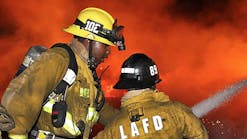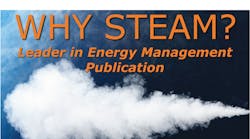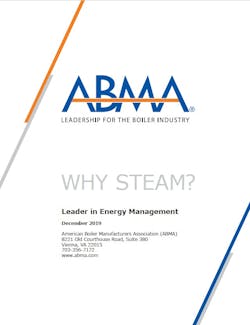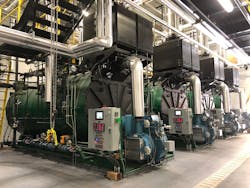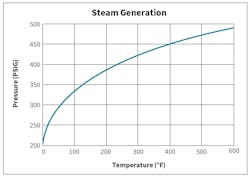By GENE TOMPKINS, Tompkins Combustion, Oshkosh, WI
DISCLAIMER: While this document is technically sound, it is advisory only and to be used as a guide for qualified personnel. This publication is not intended to be definitive, nor are the comments made regarding preferences for steam. This information is provided to share the continued relevance of steam. Any use made of the information in this publication is entirely within the control and discretion of the manufacturer and is wholly voluntary. ABMA expressly disclaims any responsibility for damages arising from the use, application, or reliance on the recommendations and information contained herein.
___________________________________
In these modern times, steam is as relevant as ever.
We often hear that steam systems are old and out of date, and that new technology will replace them. There is certainly a lot of truth in the fact that they are old systems, but it is not true that they are out of date or that they will be replaced by newer alternate technologies. Steam is used because it offers unique features that you simply can’t duplicate with other systems, which is why it has been so popular in the past and will continue to be popular in the future.
Steam is a key element in the cooking, curing, fermenting, cleaning, melting and baking processes. Without steam, industry would not be able to operate as efficiently as they do, and our economy would be much different, due to the cost and complexity of how these products would have to be made.
Major industries using steam as a critical component include food processing, pharmaceutical, chemical, oil refining, plastics, electric generation, heating, pulp and paper, textiles, metal processing, rubber production (such as tires), shipbuilding, and power generation.
I. EVOLUTION OF STEAM SAFETY
There is a long history of using steam to improve our lives. In the 1800’s, steam was used to power trains and industrial processes as part of the industrial revolution. In those early days, it provided the energy that changed the world. A common comparison is that before the steam locomotive train, it would take 6 months or more for settlers to cross the Midwest, often with much hardship. After the transcontinental railroad, you could cross it in one week, while sitting in relative comfort. Mining operations changed because they could now pump the water out of the lower levels and run trains to haul the materials.
During these times, steam was produced in a boiler fired with wood or coal. These early applications of boilers for steam generation had problems, and many fires and explosions were caused by poor design, construction, and maintenance of the boiler. This led to the founding of organizations including the American Boiler Manufacturers Association (ABMA), American Society of Mechanical Engineers (ASME) and the National Board of Boiler and Pressure Vessel Inspectors (“National Board”).
The American Boiler Manufacturers Association (ABMA) was founded in 1888 and is the longest continuous manufacturing trade association in the United States. The ABMA continues to work to improve the safety of boiler applications and users worldwide, with education and sharing helpful information from its members.
Around the same time, the American Society of Mechanical Engineers (ASME) was founded and the “Boiler Design” book was released, which greatly improved the safety of boilers and steam users. Today, boilers must be built to these codes with inspection by independent inspectors to insure safe construction.
Installation and Operation is overseen by the “National Board” which was created in 1919 to promote greater safety to life and property through uniformity in the construction, installation, repair, maintenance, and inspection of pressure equipment. Each state has a Boiler Group that monitors these boilers and provides inspections of existing boilers.
The “National Board” monitors the location of every boiler built in the United States and helps inspectors perform their duties. This is the formal structure that every boiler manufacturer must follow to have their product sold in the US and many other countries.
II. STEAM AS ENERGY
There are many reasons why steam has been and continues to be one of the primary energy transfer mediums in the world and the single most common energy transfer medium for industry...
- The source of steam is water, which is both plentiful and inexpensive. Other transfer mediums such as oil are more expensive and more difficult to access;
- The most unique property of steam is that it will provide a constant temperature. Steam can surround or be injected into a heated product, suppling heat at a constant temperature while condensing. This process of releasing heat at a constant temperature is called the latent heat of evaporation, and it contains a great amount of energy, several times more than any other heat transfer medium. This means that steam offers a heating process that is far less expensive and complex. Other mediums change temperature when releasing heat, making them comparatively more difficult to control the process temperature;
- Steam systems do not require circulating pumps as other mediums require. When it condenses, the volume of liquid is much smaller, and will automatically be replaced by more steam. This issue is not just the cost of the circulating pumps, but the challenge of controlling the pumps and their flow to manage the heat transfer of the product, especially when tight temperature control is needed;
- Steam temperature is a function of the operating pressure, so that the ideal temperature for a process can be easily maintained by simply controlling the steam pressure. No other heat transfer medium can provide this feature. A simple example is a pan of boiling water on a stove where the temperature of the water will always be 212° F, regardless of how much heat is applied or removed. Cooks use this property to heat sensitive foods like chocolate, just as they do in industrial processes, where tight temperature control is important to product quality and efficiency;
- Steam will expand when converting from water, by as much as 1700 times its water volume. This is the basis for many applications of mechanical work, as in the early steam engines, where a small amount of water was pumped into the boiler, and a very large volume of steam was produced to operate the train. This property is still used today for modern applications including steam turbines in electric generation. All nuclear electric generation is based on using the heat from the nuclear process to generate steam to drive a steam turbine, which drives the generators to produce electricity. Examples of this application have been around for many years;
- There is no chance of the steam ever causing a spark or fire, which allows it to be used in applications where there is the potential for fire or explosions;
- Steam leaks are not a source of environmental hazards when compared to leaks with other process mediums. Steam leaks do need to be addressed promptly to eliminate risk to personnel and equipment;
- Because steam is sterile, it can be directly injected into the product, simplifying the process and reducing costs.
III. ENERGY TRANSFER MEDIUM
There is often a misconception about what steam represents in the energy field. It is not a source of energy, but it is simply an “Energy Transfer Medium”. The source of energy is a fuel or some other energy source like natural gas, coal, nuclear, solar, etc. The energy source is used to heat the water and convert it to steam, and the steam is then used to heat the process or product or provide some mechanical energy. Steam only transfers the energy from the energy source to the process being heated. In some cases, it may not be a heating process, but could be a mechanical conversion to operate a steam driven turbine. It could also be used for air conditioning and refrigeration purposes with absorption chillers.
Energy sources rarely provide useful energy, and we have learned how to transfer that energy into a more useful form, as with steam. Another common energy transfer medium is electricity. Contrary to some sources, electricity is not an energy source, electricity is an energy transfer medium. Just like steam, electricity has unique properties that have made it a common means of energy transfer. It can be used to perform many different functions at the receiving end, including heating, mechanical power, air conditioning and to power electronic equipment. It is this wide variety of applications that has made electricity a popular form of energy transfer. Just like steam, an energy source is required to generate electricity which could be a power plant, solar panels or some other energy source.
It may surprise you that steam actually has a higher usage than electricity. In 2017, electricity used 38% of the total energy in the U.S. [1]. However, steam is used in 80% [2] of the electrical generation in addition to 37% [3] of the industrial energy use and a smaller amount of commercial and residential energy use.
Water is another heat transfer medium, and it shares many of the same advantages as steam. It is often used in heating where its lower normal temperatures are well suited to heating applications. Water has a lower energy content than steam, but much better than other mediums, such as oil. It also drops in temperature as it gives off heat, making it harder to control the heat transfer. For building heat, these are less critical. Also, since building heating systems can operate at lower temperatures, the combustion efficiency can be much higher. Like steam, hot water is usually generated in a boiler because of the efficiency and cost.
Other energy transfer mediums are used when steam and electricity fall short. For example, hot oil provides very high temperatures without the need for high pressures. If a process requires a temperature of 500° F for example, hot oil may be a good alternative. The fact that the oil can be heated to these temperatures without high pressures make the system less expensive and less complicated. It is also more dangerous, as the hot oil can easily cause a fire. There is also a concern with temperature control, since the oil temperature immediately drops when the heat is removed.
IV. BOILER STEAM
The production of steam is often done in a boiler, fired by fossil fuels. A boiler can use any heat source, including nuclear, solar, natural gas, coal, wood, waste fuel, or others. Today, most boilers use natural gas simply because it is clean and inexpensive. It has also become a preferred choice because it is a “Clean Fuel”. Coal and oil, two of the common fuels of the past, have high levels of ash, sulfur and NOx emissions. The conversion from these fuels to natural gas has resulted in a major reduction in “Acid Rain” and CO2 emissions on boiler applications.
Boilers are the most efficient and economical means of generating steam. Modern boilers typically have efficiencies of over 80%. When viewed from a total steam plant operation, including the motors and other heat losses, the typical efficiency is still over 75%. This compares to electric generation with efficiencies of 30 to 35% using fossil fuels. This means that more than twice as much fuel must be burned to generate the same quantity of energy from electricity as from a boiler. While some emissions are lower in a large utility, the CO2 emissions are not lower, and will be more than double that of a boiler.
V. STEAM SOURCES OF ENERGY
This chart shows the total energy used in the U.S. [1] Combustion based energy makes up about 85% of the total. All of these are good fuel sources for boilers as well as electric generation. Nuclear and hydroelectric (about 12% of the total energy) and wind and solar (about 3% of the total energy) are primarily for electric generation.
For applications that use steam, it is better to use fuels directly in a boiler to generate steam instead of generating electricity and then converting it to steam. With much higher overall efficiencies, there is a reduction of CO2 emissions as well as reduction in the amount of energy used. This is especially true in today’s boilers that use natural gas, a very clean fuel even without the additional low emission equipment.
A review of the 2018 boiler sales from ABMA shows that 91.7% of all U.S. sales have natural gas as the only or primary fuel [4]. The fact that natural gas has no sulfur or ash compared to oil and coal means that all emissions are greatly reduced by this change to natural gas fuel.
The growth of wind and solar power offer the opportunity to reduce the cost of electricity, and certainly reduce the amount of emissions. However, this only accounts for about 3% of the total U.S. energy use or about 9% of electric generation energy. In addition, electric generation from wind is often at the wrong time of the day. While there are many ways of solving these problems, solutions will not be easy or inexpensive. Even if there is a conversion to more electric generation from wind and solar, steam will still be the best means of converting electricity to a useful energy source for heating and process work. It simply means that the boiler will use electricity for its energy source.
One of the useful features of a boiler is that it can be designed to use multiple energy sources, such as natural gas and oil, or wood and natural gas or many other combinations of energy. Over the years, there has been major source shifts from coal to heavy oil and oil to natural gas or propane. While changes have been made to the burner to support these changes, the boiler often did not change. In fact, most larger boilers historically were capable of firing on many different fuels, based on availability and cost of different fuels. This flexibility has been critical to users and the community.
For example, in the northeast, during periods of limited natural gas supply, many commercial and industrial boilers were set up to automatically change from firing natural gas to oil when the temperature dropped below a certain level to prioritize residential and ensure there was enough gas supply for all residential customers.
In the northwest, there are many hydroelectric sources of electricity, which allowed the electric rates to be relatively low. Many commercial and industrial users used electric boilers to take advantage of these low energy rates. Throughout the years, boiler manufacturers have responded to the local opportunities to provide boilers that meet local needs, including wood, digester gas, landfill gas and a wide variety of industrial wastes. This will continue to be an important ingredient in future operations.
Electric generation from wind is continuing to grow, but there are challenges to overcome. Wind electricity is often being generated at night when there is a low demand for electricity. This has forced generating plants to become more dependent on generators that can quickly cycle on and off even if it is much less efficient than traditional electric generating plants. Batteries and other approaches are also being developed, but there is no simple inexpensive solution to this problem.
One solution may be to simply cycle commercial and industrial users between electric boilers and natural gas fired boilers. Similar to the automated switch from natural gas to oil in cold weather in the northeast, this could also be an automatic switch to electric boilers whenever the electric generation was larger than the normal use. When the demand for electric power comes back, the boilers can switch to natural gas to insure enough electrical supply for the consumers.
The use of steam is often hidden from our daily lives. However, it is by far the largest energy transfer medium in use today. Steam continues to be a key component in electric generation, industrial production, food & beverage and heating. The flexibility offered by steam and steam generation from boilers will continue to keep the use of steam in our foreseeable future.
VI. REFERENCES
1. “Monthly Energy Review”, U.S. Energy Information Administration, April, 2018;
2. “Industrial Combustion Boilers”, Energy Technology Systems Analysis Programme of the International Energy Agency (IEA), Technology Brief 101, May 2010;
3. “Steam Systems in Industry, Energy Use and Energy Efficiency Improvement Potentials”, Lawrence Berkeley National Laboratory. Dan Einstein, Ernst Worrell, Marta Krushuch;
4. American Boiler Manufacturers Association, derived from confidential statistical sales data provided by member companies. Sales that do not have a fuel listed (sold as a vessel only) are not included;
5. “Steam – The Energy Fluid”, Spirax Sarco Website.
____________________________________
In addition to the Why Steam publication, ABMA released the Boiler Installation Guide to address common issues impacting the safety & proper installation of boilers and Boiler Types for Steam Applications to educate end-users on the options in the marketplace and detail the pros and cons for specific applications.
Those interested in boilers should also check out Episode #15 of the Inside the Boiler Room podcast, featuring author and industry thought leader Ray Wohlfarth, president and CEO of Fire and Ice Heating and Cooling, Pittsburgh PA. This episode features a discussion on the benefits of boilers for the commercial sector and compares commercial boilers to other options in the marketplace in terms of safety, reliability, efficiency and maintenance. Other recent episodes of the podcast include “Burner Technology for Firetube Boilers” with Bob Rizza of Power Flame Inc., Parsons KS, and Eric Graham of Webster Combustion Technology, Wichita KS, and “Boiler Drum Level Instrumentation”, with Jim Kolbus of Clark-Reliance Corp., Strongsville OH.
All episodes of the Inside the Boiler Room podcast can be accessed on all major podcast platforms including Apple Podcasts, Stitcher and Google Play.
To download Why Steam, or any other ABMA publication, please visit www.abma.com.
_____________________________________________________
Now an ABMA technical consultant, Gene Tompkins is a mechanical engineer with more than 40 years of experience in the boiler-burner business. He served 27 years at Cleaver Brooks and another 11 years at Webster Engineering before retiring in 2013.







